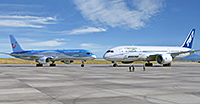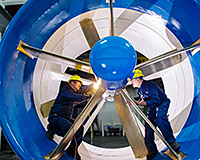Designing
the Future
New Technology

As a technology and innovation leader, Boeing is investing to improve the fuel efficiency and environmental performance of our products, services and operations. The company takes into account environmental performance at every step of a product’s life cycle — from materials, design and manufacturing, through in-service use and end-of-service recycling and disposal. We call this strategy Design for Environment.
Boeing is also accelerating the development and testing of new technologies bringing fuel efficiency and environmentally progressive advancements for our customers and our communities around the world.
ecoDemonstrator Program
The Boeing ecoDemonstrator Program is focused on accelerating the testing, refinement and completion of new technologies to improve aviation’s environmental performance. It also looks for opportunities to improve environmental sustainability across the airplane’s life cycle: from design and manufacturing to in-service operations and end of service. Boeing has partnered with selected suppliers, airlines and government agencies on this multiyear program, including NASA and the U.S. Federal Aviation Administration Continuous Lower Emissions, Energy, and Noise (CLEEN) program on a number of ecoDemonstrator Program activities.
Later this year, Boeing will begin using one of its own 787 airplanes for the ecoDemonstrator Program to install and test environmentally progressive technologies to advance the goals
of reducing emissions, improving fuel efficiency, reducing noise, using more sustainable materials, and making flight paths more logical and efficient. Some of the technology is hardware installed on the airplane; some of it is advanced software or instrumentation. Boeing plans to use a 757 platform for testing in 2015 for the ecoDemonstrator Program.
Digital Aviation
Until recently, pilots often carried heavy flight cases with up to 50 pounds (22.68 kilograms) of navigation charts and flight manuals to guide planes to their destinations. Today, aviation is rapidly moving away from paper in favor of mobile devices that are lightweight and offer interactivity and customizable information.
Through its Digital Aviation unit, Boeing is developing products and services that enable more efficient flight, saving fuel and time, and reducing greenhouse gas emissions and operating costs. An example of this is a mobile application, developed by Jeppesen, a Boeing subsidiary, that provides all the information traditionally included on paper charts. The application saves fuel by reducing the amount of weight carried aboard the aircraft. Other examples include Wind Updates and Direct Routes, which provide customized, real-time information about operating speeds, altitudes and routings that help pilots operate airplanes with optimal efficiency.
Hydrokinetic Power
Boeing and RER Hydro of Montreal have signed an agreement with the government of Quebec to provide more than 40 hydrokinetic turbines that will generate about 9 megawatts of clean, renewable power.
Once the project is completed, the St. Lawrence River near downtown Montreal will have the world’s largest river-generated, hydrokinetic turbine farm.
RER, which has been testing a prototype in the river for more than three years, will build the turbines, and Boeing will provide program management, engineering, manufacturing and supplier management expertise. Boeing will also service the turbines.
Shining Solar Alternatives
Spectrolab, part of Boeing Defense, Space & Security, is the world’s leading supplier of high-efficiency multijunction solar cells, panels for concentrated photovoltaic and spacecraft power systems, and airborne searchlights.
In 2013, Spectrolab set a new world record by producing a solar cell that converted 38.8 percent of solar energy into electricity, beating its previous own world record of 37 percent.
The high-efficiency multijunction solar cell was developed from new Boeing semiconductor bonding technology, which can be used to power spacecraft and unmanned aerial vehicles.
In early 2014, Boeing announced it would provide engineering, procurement and construction expertise to NRG Energy, Inc. for the island nation of Guam’s first solar power plant.
Once completed, the new solar facility will generate 25 megawatts, enough clean energy to power 10,000 homes and offset consumption of almost 2 million barrels of fuel oil and diesel. The energy generated also will help Guam achieve its renewable energy goals by 2015.
Recycling Composites
Boeing leads the commercial aviation industry in increasing the use and recycling of composites. Composite materials, such as those used in the Boeing 787 DreamlinerTM, allow a lighter, simpler structure, which increases efficiency and reduces greenhouse gas emissions, and do not fatigue or corrode like traditional metal alloys. In yachts, composite construction also provides the ability to develop a lighter vessel that is stronger and stiffer at the same time.
Boeing is working with ORACLE TEAM USA, winner of the 34th America’s Cup, to transform the science of sailing and of composite recycling. Along with research partners, Boeing and ORACLE TEAM USA are collaborating to recycle 7,000 pounds (about 3,175 kilograms) of carbon fiber of USA-71, a yacht built for the America’s Cup campaign in 2003. Boeing and ORACLE TEAM USA expect to gather data about the mechanical properties, costs and time flows to recycle sailing-grade composite materials in comparison to aerospace-grade and automobile-grade composites.





